When researchers at Penn State University first looked at the artifact, they thought it to be a leather moccasin. The cave located in Bolivia’s Andes was being studied by researches as it was the location of an ancient sepulcher where, for centuries, grave robbers have been plundering funeral objects, leaving behind only objects of little value. The scholars from the US university only understood that this leather accessory was actually a pouch later on. The sack contained a shaman’s tools, such as bone spatulas, small pipes and a pouch made of three fox’s snouts sown together. While the radiocarbon analysis allowed scholars to date the objects between 900 and 1170, the chemical one showed them the contents of the pouch, which is what made this discovery jump from good to great. The shaman’s purse included, summarizes National Geographic, various different psychoactive substances, including the ones used to make ayahuasca: the bag could be the first piece of information, precious even if not resolutive, to date the consumption of the hallucinogen drink in South America.
Proof of hallucinogens being used by Andino shamans over 1000 years ago was found in a leather pouch











